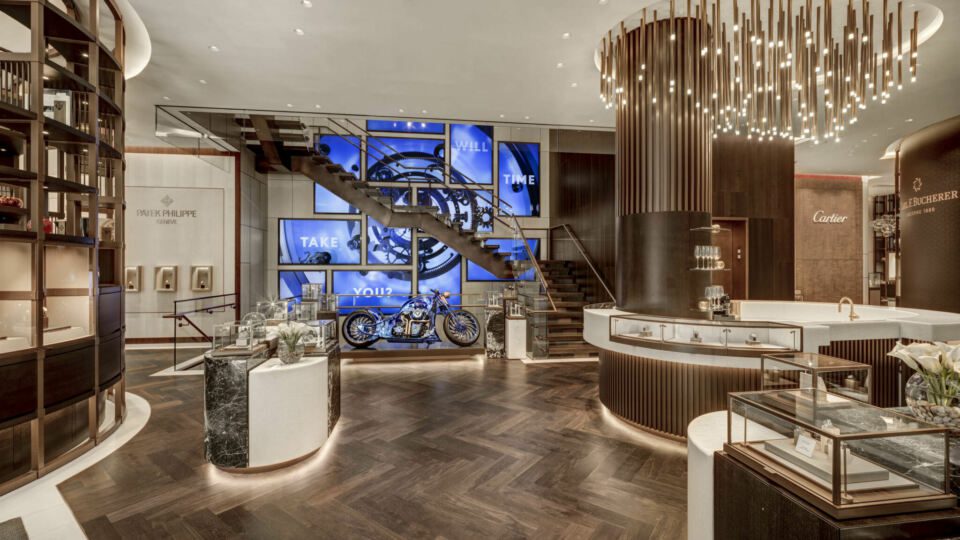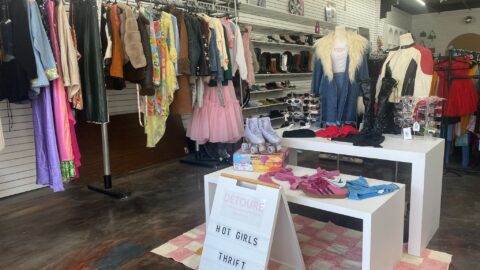The shop-in-shop retail approach can yield benefits for both the host retailer and the hosted brand, but there are certainly challenges to entering into this type of partnership. At their core, shop-in-shop models must remain a true partnership between both brands, with each bringing their own branding to the table in order to effectively blend their design messaging.
“Hopefully, as a brand, both sides are doing their homework up front and making sure they understand the value proposition to the customer of why this shop-in-shop makes sense to coexist in this environment,” said Melissa Gonzalez, CEO and Founder of retail strategy firm The Lion’esque Group in an interview with Retail TouchPoints. “Is it a complementary offering to the other core products that are sold? How is it appealing to the customer? I think when you don’t do that homework up front, then it’s not as positioned for success.”
The retail design elements of a shop-in-shop location must respect the environment of the host retailer but also speak to the customer by communicating the distinctiveness of the hosted brand. As Gonzalez noted, both the host and the hosted brand must prepare before embarking upon their partnership. Carefully considering the following questions will support harmony within the shop’s design elements and the relationship between the partners:
- How much space will the hosted shop-in-shop need from the host brand?
- Would standing out or blending within the host environment drive the most traffic to the shop-in-shop?
- In addition to design, how can the brands link their offerings through perks such as combining rewards programs, hosting events or providing expert consultations?
- How can the hosted brand stand out within the host’s space?
“If you walk into a shop-in-shop and you remove the signage, and then you go into the next shop-in-shop and you remove [its] signage, do you feel like you’re in the same space?,” asked Helen Herrick, Director at MBH Architects in an interview with Retail TouchPoints. “Making sure the elements — every element — reads as your brand is important to connect with the customer and make them excited about your brand, rather than just ‘Oh I am just stopping here for a second but it all looks the same to me.’ If you remove your sign and your customer doesn’t know where you are, maybe you need to look at your finishes, your shelving, the micro design to make sure it catches up with the overall brand image.”
Advertisement
Making Space for a Shop-in-Shop Partner
One of the first decisions to be made is how much of the host retailer’s valuable real estate is necessary to successfully engage with customers.
“The retailer has to make room for the shop-in-shop brand presence and ensure that the shop-in-shop experience doesn’t interrupt the store’s overall flow,” said Scott Schoeneberger, Managing Partner at design-focused technology firm Bluewater in an interview with Retail TouchPoints. “It’s also about determining where the shop-in-shop will be seen and where it will drive the most traffic. Color and lighting are really important, as they help the shop stand out.”
In August 2021, as more shoppers were returning to brick-and-mortar retail, Ulta Beauty joined forces with Target to create a shop-in-shop experience within the big box retailer’s stores. Approximately 1,000 square feet of Target’s floor space was dedicated to each Ulta Beauty at Target location, and the partnership resonated with customers loyal to both companies.
After launching 100 shop-in-shop locations in 2021, the retailers laid out plans at the beginning of 2022 to add more than 250 new Ulta Beauty at Target locations by the end of the year and to eventually reach at least 800.
“When we launched Ulta Beauty at Target last August, we knew it was something special,” said Kecia Steelman, COO at Ulta Beauty in an interview with Retail TouchPoints. “Performance is strong and we’re thrilled to see new and familiar guests engage with our one-of-a-kind shopping experience. Guests are loving our curated prestige assortment across leading skin, makeup, haircare and fragrance brands, and are enjoying the benefits of our two amazing loyalty programs.”
A Wide Range of Design Options
While no single design formula exists for a shop-in-shop experience, there are guidelines that retailers and the brands they host should keep in mind. As Schoeneberger notes, each retailer differs regarding how much distinction it prefers between the hosted brand and its own messaging.
“Some may not mind that a store-within-a-store concept pops out from the rest of the environment,” said Schoeneberger. “In these scenarios, you will often see different flooring, wall coverings, display cases, fixtures and activations used. However, other retailers prefer to protect their brand. These shop-in-shop buildouts might be much more subtle — an entire display case that’s entirely reserved for a single brand, or an entire aisle or rack bay dedicated to a specific brand. While these might not jump out as much, there are subtle cues to draw customers in, and the products being clustered can help to create a bit of pop.”
For hosts willing to let a brand create a space that resembles its own shop within the larger store, customers are afforded the opportunity to become fully immersed in an experience provided by the guest brand. Retailers that can provide a closed-off space, similar to a private room in a restaurant, can maximize this type of immersion.
“Occasionally, you will have a retail space that allows for an entirely sectioned-off zone — a room within a store,” said Schoeneberger “This type of setting can provide the best of both worlds — allowing the retailer to maintain its brand, while within the closed-off space, another brand can take over and let its brand shine.”
Designing a Collaborative Shop-in-Shop Space
The road to shop-in-shop success must include design elements that align with a targeted mission, and these spaces must be organized mindfully. “It’s really important that it feels purposeful and still feels like a brand moment regardless of the footprint,” said Gonzalez. “It’s still an impression. Being a curated experience; that’s the point. It’s not about being all things to all people. It’s about being very pointed in what you’re showcasing.”
The Ulta experience at Target features clean lines within a well-lit space that align perfectly with the beauty product shopping experience. Within its design scheme, Ulta included messaging true to its brand as it highlighted products that fit within the Target environment. It also blended into the retailer’s atmosphere without an overpowering presence.
“Not only are we driving traffic, awareness and building affinity for our brands, we’re providing greater access to some of the most coveted names in beauty, including The Ordinary, Tarte, Pattern and Ariana Grande,” said Steelman. “We’re excited to continue to build on the success of our dynamic partnership and expand to more locations in the coming year.”
Host retailers don’t have to wall off spaces within their stores in order to provide individual brands with their own differentiated selling areas. A recently opened retail concept by luxury timepiece and fine jewelry house Carl F. Bucherer saw the development of a Bucherer 1888 TimeMachine flagship at Madison Avenue and 57th Street in NYC. Constructed at the historic site of the Tourneau Time Machine, Bucherer included within its nearly 19,000-square-foot space offerings by Tourneau — which it acquired in 2018 — in addition to spaces for luxury jewelers and watchmakers including Breguet, Cartier, IWC, Jaeger Le Coutre, Patek Phillippe, Tag Heuer and Vacheron Constantin.
“We just finished the Bucherer store and many brands are represented in that space,” said Herrick. “There is a cohesive look of the entire store, but each of those brands has its own carpet, its own signage and its own lighting. Although there are not physical walls built around each of those brands, it’s very clear that the feel of that space belongs to that brand.”
Some shop-in-shop designs are used to house a host retailer’s own distinct concept, an approach that has proved successful for Macy’s, which launched its off-price customer experience in 2015 with Macy’s Backstage. In addition to standalone Macy’s Backstage locations, the retailer also relies on a store-in-store model selling discounted goods only steps away from its full-price items.
“Macy’s Backstage is a perfect complement to the Macy’s department store and becomes a one-stop-shop,” said Michael Hersh, VP of Off-Price at Macy’s in an interview with Retail TouchPoints. “Putting Backstage stores within stores offers our customers the ‘treasure hunting’ of off-price shopping without having to leave the store. Macy’s Backstage helps give the customer access to the fullness of the Macy’s brand, from off-price to luxury.”
Riding on the success of its own store-in-store concept, Macy’s Backstage launched at the Macy’s Chicago flagship April 9, 2022, and held the grand opening at its Herald Square location in Manhattan on May 20. By Memorial Day 2022, Macy’s Backstage boasted 300 locations.
Maintaining Shop-in-Shop Momentum
Los Angeles retailer Fred Segal has been a pioneer of shop-in-shop experiences, working with brands including Armani, Fiorucci and Versace in addition to retailers such as the UK-based Browns and Japan’s Beams. Fred Segal owner Jeff Lotman, who is also CEO of Global Icons, noted that the shop-in-shop concept has been part of the Fred Segal heritage since the retailer opened in the 1960s, but as with today’s model there’s a strong desire for brands to collaborate.
“Back then, they didn’t even call them shop-in-shops, they were just people that Fred knew that really wanted the opportunity to build their own businesses,” said Lotman. “Over the years, our approach to shop-in-shops really hasn’t changed that much. On Sunset [Boulevard], we have two activation spaces — one large and one small — where we do a lot of pop ups.”
A key component of the Fred Segal approach is providing opportunities for its customers to have a different retail experience through these collaborations. When they provide new experiences, retailers and their partners win by becoming known for serving up fresh approaches.
“It’s a great way for customers to get something that they wouldn’t normally get otherwise,” said Lotman. “The most important thing retailers need to think about is how these types of things are going to excite customers because, let’s face it, the name of the game is getting more people in your store so they can see what you have, and hopefully get excited about purchasing it. Also, for a brand, it is a great way to showcase a limited edition set of products and really roll things out.”









